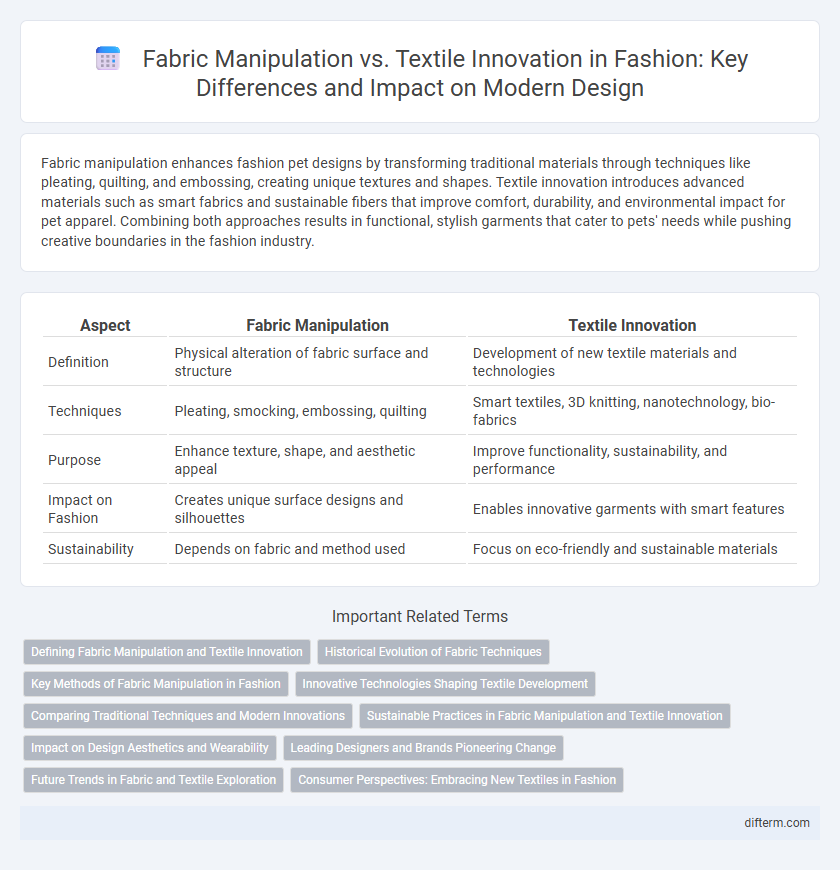Fabric manipulation enhances fashion pet designs by transforming traditional materials through techniques like pleating, quilting, and embossing, creating unique textures and shapes. Textile innovation introduces advanced materials such as smart fabrics and sustainable fibers that improve comfort, durability, and environmental impact for pet apparel. Combining both approaches results in functional, stylish garments that cater to pets' needs while pushing creative boundaries in the fashion industry.
Table of Comparison
| Aspect | Fabric Manipulation | Textile Innovation |
|---|---|---|
| Definition | Physical alteration of fabric surface and structure | Development of new textile materials and technologies |
| Techniques | Pleating, smocking, embossing, quilting | Smart textiles, 3D knitting, nanotechnology, bio-fabrics |
| Purpose | Enhance texture, shape, and aesthetic appeal | Improve functionality, sustainability, and performance |
| Impact on Fashion | Creates unique surface designs and silhouettes | Enables innovative garments with smart features |
| Sustainability | Depends on fabric and method used | Focus on eco-friendly and sustainable materials |
Defining Fabric Manipulation and Textile Innovation
Fabric manipulation involves techniques such as pleating, gathering, and smocking to alter the texture and structure of a material, enhancing design details and garment dimensionality. Textile innovation refers to the development of advanced materials and technologies, including smart textiles, sustainable fibers, and 3D-knitting, which transform functionality and performance in fashion. Both approaches drive creativity, with fabric manipulation focusing on manual craftsmanship and textile innovation emphasizing scientific advancement.
Historical Evolution of Fabric Techniques
Fabric manipulation traces its roots to ancient handcraft traditions like pleating and smocking, showcasing artisanal creativity through texture and form. Textile innovation emerged during the Industrial Revolution with mechanized weaving and dyeing, revolutionizing fabric production and expanding material possibilities. The historical evolution of fabric techniques reflects a dynamic interplay between handcrafted artistry and technological advancement, shaping contemporary fashion design.
Key Methods of Fabric Manipulation in Fashion
Key methods of fabric manipulation in fashion include pleating, smocking, and ruching, each altering the texture and structure of textiles to enhance garment aesthetics. Techniques like heat-setting and laser cutting allow designers to create intricate patterns and three-dimensional forms directly on fabric surfaces. These manipulation methods play a crucial role in achieving unique silhouettes and tactile experiences, distinguishing innovative fashion collections.
Innovative Technologies Shaping Textile Development
Innovative technologies such as 3D knitting, laser cutting, and digital printing are revolutionizing textile development by enabling precision and customization in fabric manipulation. Advanced materials like smart textiles incorporate sensors and responsive fibers to elevate functionality beyond traditional fabrics. These technological advancements accelerate sustainable practices and expand creative possibilities in fashion design.
Comparing Traditional Techniques and Modern Innovations
Fabric manipulation encompasses traditional techniques such as pleating, smocking, and applique, emphasizing handcrafted skills and tactile texture enhancements. Textile innovation integrates cutting-edge technologies like 3D knitting, smart fabrics embedded with sensors, and sustainable bio-fibers to create functional, adaptive materials. Comparing both reveals a blend of artistry and science, where heritage craftsmanship meets technological advancement to redefine fashion design.
Sustainable Practices in Fabric Manipulation and Textile Innovation
Sustainable practices in fabric manipulation emphasize reducing waste through techniques like zero-waste pattern making and fabric upcycling, minimizing environmental impact. Textile innovation incorporates eco-friendly fibers such as organic cotton, bamboo, and recycled polyester, alongside advancements in biodegradable and low-water dyes. These methods collectively drive the fashion industry toward circularity and resource efficiency.
Impact on Design Aesthetics and Wearability
Fabric manipulation techniques such as pleating, ruching, and smocking add dimensionality and texture, enhancing design aesthetics by creating sculptural silhouettes and intricate surface details. Textile innovation introduces advanced materials like smart fabrics and sustainable fibers, improving wearability through increased comfort, durability, and functionality while maintaining or elevating visual appeal. The fusion of both approaches drives contemporary fashion by balancing artistic expression with practical performance.
Leading Designers and Brands Pioneering Change
Leading designers such as Iris van Herpen and brands like Issey Miyake have pushed the boundaries of fabric manipulation by integrating cutting-edge technologies and experimental techniques. These pioneers use 3D printing, laser cutting, and smart textiles to transform traditional textiles into dynamic, responsive materials that redefine garment construction and aesthetics. Their innovative approaches not only elevate fashion design but also drive sustainability by reducing waste and promoting creative reuse of fabrics.
Future Trends in Fabric and Textile Exploration
Fabric manipulation techniques like pleating, draping, and smocking are evolving through integration with smart textiles, enabling responsive and adaptive garment designs. Textile innovation increasingly incorporates sustainable materials such as bio-engineered fibers and recycled polymers, driving eco-conscious fashion trends. Advanced technologies like 3D knitting and digital printing continue to reshape future fabric exploration, enhancing customization and functional performance.
Consumer Perspectives: Embracing New Textiles in Fashion
Consumer perspectives on fabric manipulation versus textile innovation reveal a growing preference for sustainable and functional materials in fashion. Innovative textiles such as bio-fabricated leather, moisture-wicking fabrics, and recycled fibers appeal to eco-conscious buyers seeking durability and ethical production. Fabric manipulation techniques enhance the aesthetic and tactile qualities, but the emphasis remains on innovative textiles driving consumer demand for responsible and performance-oriented fashion choices.
fabric manipulation vs textile innovation Infographic

 difterm.com
difterm.com